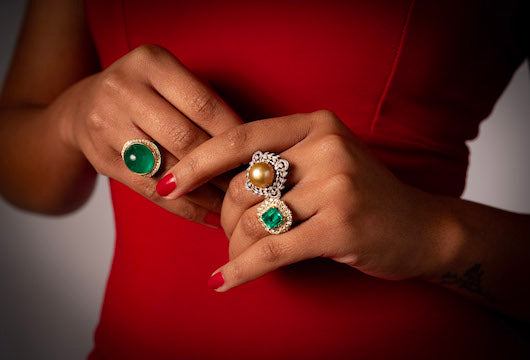In Part 1: The Art of Lapidary, we explored how colored stone rough is transformed into faceted jewels, the assessments a lapidary artist must make of each piece of rough before determining the best cut for each specimen, and the most popular gemstone cuts. This week, we are continuing the discussion of factors contributing to the quality of a finished gem in Part 2 of the series: Gemstone Cut Quality Indicators.
Although there are many nuances in what contributes to the best possible cut for each stone, some variables must by and large remain constant to ensure quality. Symmetry, polish, and facet alignments are generally good indicators of how much attention to detail a lapidary artist devoted to the finished jewel.

Symmetry in a well-cut Burmese gray spinel lends brilliance and beauty to an already exceptional gemstone.
Symmetry
The outline, or shape of the stone, should roughly mirror its opposing side when viewing the gemstone face-up. Imagine separating the face of the stone into segments – each segment should resemble its immediate adjacent. Significant deviations from symmetry impact the perception of a finished gem’s quality and value. In some cases, the deviations may be balanced by retaining a larger portion of the stone’s rough weight, but this is largely correlated with the rarity and desirability of the gemstone. For example, if asymmetry results in retaining a much higher weight than typically found for a specific gem, sometimes symmetry is sacrificed - but, the value per carat will be less than for an example with a more regular, aesthetically pleasing body outline.
Tables should be parallel to the girdle, centered, and follow the outline of the stone’s shape, while shoulders on fancy cuts should be evenly matched and neither too narrow nor too broad.
Likewise, the culet at the base of the stone should be centered, although some rare exceptions to the rule do apply when an off-center culet provides a more even, vibrant dispersion of color throughout the gemstone (see the discussion of native cut gems below).

Well-placed facet meets provide the vehicle for maximum light return in these octahedral cut Burmese spinels.
Facet Meets and Makes
Gemstone facets should mirror each other for greatest brilliance in a cut stone. If facets deviate in symmetry to the point that it is visible to the naked eye, it can be an indicator of poor workmanship. Alignment of the crown and pavilion facets, especially in step and designer cuts, is equally important. While of lesser significance in pear, cushion, and oval cuts, misalignment in hearts in particular can result in mismatched lobes and oddly placed center clefts. While in some cases bezels and other mountings can be strategically used to minimize the impact of poor alignment, it is better to choose stones that already embody these characteristics.
Facet junctions should also be sharp and crisp, as opposed to slightly rounded. The exactness of these junctions allows for greater light reflection and brilliance. Overall, straight lines and meet points in a well-cut gemstone are a sign of quality and care taken on the part of the lapidary artist.

Exceptional polish on these Burmese red spinels creates an attractive overall outline reminiscent of a heart.
Polish
Together with facet meet points, polish is a good indicator of the overall time and effort taken to create a finished gem. Gemstone facets should be smooth and mirrorlike when examined with a loupe, without any signs of abrasions or scratching. A smooth appearance indicates that the lapidary artist was thorough in moving through the subsequent levels of polish and grit to achieve the optimum refractive quality for the gemstone facets.
Girdle Thickness
The girdle of a gemstone is particularly important because it is where the stone is held in place by its prongs or bezel. Essentially, the girdle serves as the anchor of the stone in its mounting. Thin girdles should be avoided because the thinner margins make it easier to chip exposed edges, especially in stone that come to an abrupt point or corner like emerald cuts, pears, and hearts. In some cases, cutters will even round girdle edges to avoid chipping them when setting. Marginally thicker girdles at these spots can also help minimize the risk of chipping, but only up to a point, as extremely thick girdles are difficult to set. The decision to round the girdle means that the girdle edge may not come to a sharp edge where the girdle meets the crown or pavilion, but the loss in sharpness is balanced by reduced risk of damage to the gemstone.
As in cases of desired relative depth or shallowness for an ideal gem cut, exceptions always arise. Native cut gems often exhibit irregular faceting on the pavilion and off-center culets. While these characteristics can be indicative of crudely fashioned faceting tools, they can also be deliberately applied with judicious intention to improve one of the most important factors in a colored stone - color. These faceting arrangements can actually spread color more consistently throughout the stone, resulting in a more uniform vibrant tone. If a cutter is able to skillfully meld elements like a skewed culet and irregular facets with an overall impression of symmetry in the stone, native cut rubies, sapphires, and other highly desirable stones can often be more expensive than those cut with more modern, conventional methods. Recutting gems like the example above to enhance the overall cut of the stone almost inevitably results in a sacrifice of color quality.
While it is not unusual for gem traders to consider re-cutting a poorly cut gem, the additional expense and weight loss must be carefully weighed against what will be gained. Like any component of a finished gemstones appearance, the factors outlined above must be evaluated on a one-to-one basis for each gem, carefully weighing the pros and cons of each decision before a final determination is made.
The take-away is that while solid craftmanship with good overall finish, polish and symmetry in commercial stones greatly enhances the overall appearance and desirability of a gem, one should not immediately dismiss more traditional cutting methods if their use enhances the color dispersion, and thus beauty, of the gemstone in question.


